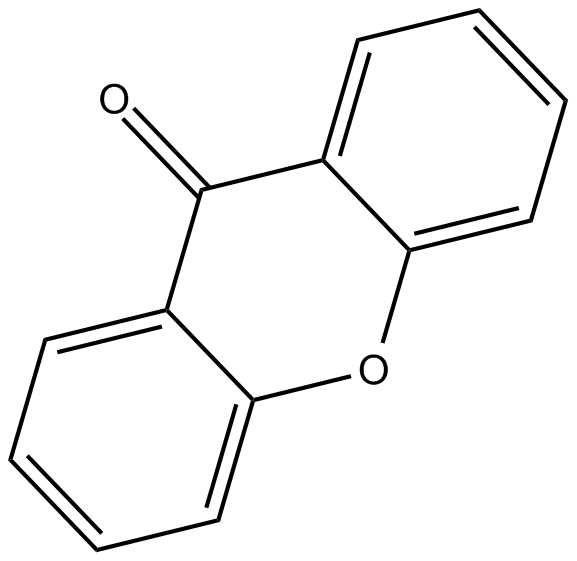Xanthone (Synonyms: NSC 14978, 9-oxo Xanthone, 9-Xanthone) |
| Catalog No.GC17356 |
La xanthone est isolée du mangoustan et est connue pour contrÔler la division et la croissance cellulaires, l'apoptose, l'inflammation et les métastases À différents stades de la carcinogenèse.
Products are for research use only. Not for human use. We do not sell to patients.

Cas No.: 90-47-1
Sample solution is provided at 25 µL, 10mM.
Xanthone shows the antagonism of endogenous nitric oxide synthase (NOS) inhibitors, it has antitumor, antihepatotoxic, anti-inflammatory and antimicrobial activities [1]. Two derivatives of xanthone potently inhibited nitric oxide synthesis with IC50 values of 4.3 and 4.4 μM, respectively [2].
In endothelial cells, NOS synthesizes nitric oxide (NO) from L-arginine. In the maintenance of vascular structure and tone, NO has been thought to play a key role [1].
Asymmetric dimethylarginine (ADMA) is synthesized by protein arginine methyltransferases (PRMTs), using S-adenosylmethionine as methyl group donor. Dimethylarginine dimethylaminohydrolase (DDAH) degrades ADMA to L-citrulline and dimethylamine. There are two different isoforms of DDAH, DDAH-1 and DDAH-2. Typically, DDAH-1 is found in tissues containing neuronal NOS, whereas DDAH-2 predominates in tissues expressing the endothelial isoform of NOS. In cultured endothelial cells, xanthones showed the inhibition of the upregulation of MCP-1 expression, the enhancement of monocytes adhesion and the increase in the release of LDH, concomitantly with the reduction of ADMA levels. These results suggest that xanthones protect against high-lipid-level-induced endothelial damage. This protective effect of xanthones is related to the reduction of ADMA concentration [1].
A single injection of native LDL caused a rapid accumulation and oxidation of LDL in the arterial wall. At 6 to 12 h after injection of LDL, ICAM-1 expression increased and led to endothelial dysfunction and an elevation of ADMA level. In vivo, pretreatment with xanthones attenuated the effect of the injection of LDL [1].
References:
[1]. Jiang DJ, Dai Z and Li YJ. Pharmacological effects of xanthones as cardiovascular protective agents. Cardiovasc Drug Rev, 2004, 22(2):91-102.
[2]. Boonnak N, Khamthip A, Karalai C, et al. Nitric Oxide Inhibitory Activity of Xanthones from the Green Fruits of Cratoxylum formosum ssp. pruniflorum. Australian Journal of Chemistry, 2010, 63(11):1550-1556.
Average Rating: 5 (Based on Reviews and 13 reference(s) in Google Scholar.)
GLPBIO products are for RESEARCH USE ONLY. Please make sure your review or question is research based.
Required fields are marked with *




















